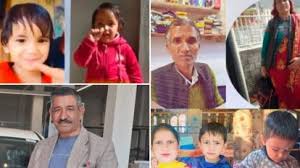‘Holding on to hopeless hope’: 11 people, including 5 children, missing since June 30 cloudbursts in Himachal’s Mandi

Mandi, Himachal Pradesh — In the picturesque but perilous hills of Himachal Pradesh, devastation struck on the night of June 30, when a series of cloudbursts triggered deadly landslides and flash floods across Mandi district. Over a week later, 11 people remain missing, including five children, as frantic search and rescue operations continue amidst crumbled homes, collapsed roads, and a rising sense of despair among the villagers.
Vanished Without a Trace
In the Thunag subdivision’s remote Deji village, nestled along the banks of a now-raging rivulet, two entire families have disappeared. Among them are elderly residents, mothers, and toddlers—each one a vivid memory now fading into uncertainty.
Gokul Chand (61), his wife Dulma Devi (55), their daughter-in-law Bhuvneshwari Devi (29), and two grandchildren—Suryansh (9) and Urvanshi (3)—were in their home when the torrential downpour triggered the landslide. In the same hamlet, Kanta Devi (32) and her daughters Ekta (10), Bhivanshi (5), and Khushi (3) also vanished.
Additionally, Sohan Lal (51), a government schoolteacher known for his community service, is also untraceable. A woman, yet to be identified, is feared buried in the debris.
“We are holding on to hopeless hope,” said Gokul Chand’s neighbor, his eyes scanning the mountainside now covered in a thick layer of mud and broken trees. “It’s been days. The river returned to its banks, but they never did.”
A Night of Chaos
Locals describe the June 30 night as one of deafening rains, sudden darkness, and the terrifying roar of water sweeping through the valley.
Within minutes, landslides consumed roads and swallowed entire structures. One survivor recalled hearing the rumble before their house began shaking. “We didn’t even have time to step out. The hills just opened up,” said a farmer from a nearby village.
Reports confirm that cloudbursts struck Deji and adjoining areas in Thunag around midnight, setting off cascading floods that overwhelmed even concrete structures. The sudden surge left roads impassable and communications cut off for days.
Search and Rescue: A Race Against Time
Rescue efforts have been intense but agonizingly slow. Teams from the NDRF, SDRF, Army, ITBP, and Home Guards have been deployed across Thunag, Gohar, Karsog, and Seraj subdivisions. Sniffer dogs, drones, and earth-moving equipment have been brought in to scour the debris.
Over 250 personnel are working across multiple sites in Mandi. Still, no signs of life or remains have been recovered from Deji village. “We’ve cleared almost 30 feet of debris in some areas,” said a rescue official. “But the terrain is unstable. Every step poses a danger.”
What further hampers the rescue is continuous rainfall, poor visibility, and blocked access routes. The village of Deji remains partly cut off, with collapsed bridges and landslides choking roads.
District-Wide Devastation
Mandi is among the worst-hit districts in Himachal Pradesh following the recent wave of extreme weather. As per the latest reports:
- 10 to 14 people have been confirmed dead.
- At least 31–34 people are still missing.
- Over 400 roads are shut, isolating several communities.
- 140–994 power transformers are damaged.
- Water schemes and telecommunication lines remain disrupted in multiple locations.
Entire families are either homeless or untraceable, and property damage has been pegged at ₹407 crore in Mandi alone. Officials fear that these figures may rise as more inaccessible areas are surveyed.
Relief Measures Underway
Despite the challenges, the administration is trying to reach every affected household. Over 1,538 ration kits have been distributed so far. Around ₹12.44 lakh has been provided as immediate assistance to the most vulnerable families.
The Health Department has organized mobile medical camps that have already treated over 270 people, many suffering from injuries, infections, and trauma-related symptoms.
Restoration of connectivity remains a top priority. In some regions, satellite phones and walkie-talkies are being used as interim communication methods. Temporary roads have been laid using JCBs and tractors to facilitate aid movement.
Wounds That Time Can’t Heal
Beyond the physical damage lies the emotional toll. In Deji, hope is beginning to flicker out. “We know they’re gone, but no one can grieve until we find them,” said a grieving mother whose daughter and grandchildren are missing.
Villagers have taken to gathering at the remnants of their loved ones’ homes, lighting candles, praying, and sometimes just sitting in silence. Some refuse to leave the site, clinging to the belief that their missing family might still be found under the wreckage.
Officials admit privately that the likelihood of survival is now minimal, but the operation will continue “until every possibility is exhausted.”
Extreme Weather on the Rise
Experts link this disaster to increasingly frequent and intense cloudbursts, a pattern that has gripped the Himalayan region over the past decade. Himachal, with its fragile ecology and unregulated construction, is now at the frontline of climate vulnerability.
According to meteorological data, Mandi recorded 1,900% excess rainfall on July 1, the highest anomaly in decades. Scientists warn that unless immediate climate mitigation and sustainable development plans are implemented, such events will become the norm.
Conclusion: An Unanswered Prayer
As Himachal reels under the weight of another monsoon tragedy, the missing people of Deji village have come to symbolize a larger crisis—of nature’s fury, of human loss, and of resilience amid despair. With every passing day, their families pray, dig, and wait.
Because sometimes, all that’s left is to hold on to hopeless hope.






